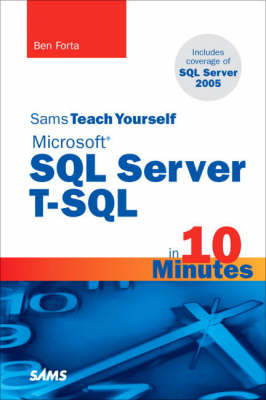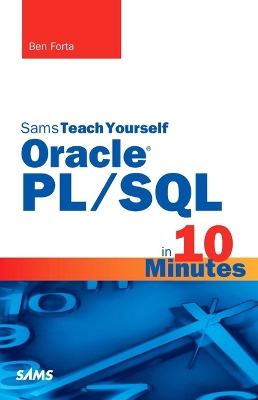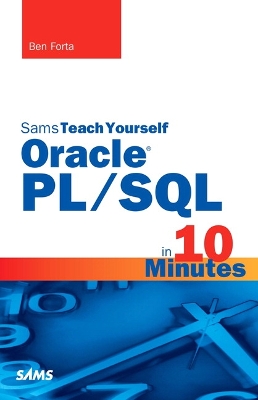Sams Teach Yourself
6 total works
Sams Teach Yourself Microsoft SQL Server 7 in 10 Minutes is a short but detailed reference to Microsoft SQL Server 7. This book brings together the most common commands and tasks that programmers and database administrators need to perform. Concise, goal-oriented lessons allow you to get up to speed quickly and efficiently. Application developers and administrators who are new to Microsoft SQL Server will learn to store, retrieve, and manipulate data in a Microsoft SQL Server database. This book serves as a reference guide even after you have become proficient.
Sams Teach Yourself Microsoft SQL Server T-SQL in 10 Minutes offers straightforward, practical answers when you need fast results. By working through 10-minute lessons, you’ll learn everything you need to know to take advantage of Microsoft SQL Server’s T-SQL language.
This handy pocket guide starts with simple data retrieval and moves on to more complex topics, including the use of joins, subqueries, full text-based searches, functions and stored procedures, cursors, triggers, table constraints, XML, and much more.
You’ll learn what you need to know methodically, systematically, and simply–in highly focused lessons designed to make you immediately and effortlessly productive.
Tips point out shortcuts and solutions
Cautions help you avoid common pitfalls
Notes explain additional concepts, and provide additional information
10 minutes is all you need to learn how to…
- Use T-SQL in the Microsoft SQL Server environment
- Construct complex T-SQL statements using multiple clauses and operators
- Filter data so you get the information you need quickly
- Retrieve, sort, and format database contents
- Join two or more related tables
- Make SQL Server work for you with globalization and localization
- Create subqueries to pinpoint your data
- Automate your workload with triggers
- Create and alter database tables
- Work with views, stored procedures, and more
Register your book at www.samspublishing.com/register to download examples and source code from this book.
RegEx is supported in all major development environments (for use in editing and working with code) and will thus appeal to anyone using these tools. In addition, every JavaScript developer should be using RegEx, but most don't as it has never been taught to them properly before. Developers using ASP, C#, ColdFusion, Java JSP, PHP, Perl, Python, and more can (and should) be using RegEx, and so every one of them is a potential reader too. The reader of this book will learn how to:
Match characters sets Match repeating characters (using minimums and maximums if needed) Match (or ignore) based on case Build sub-expressions Use all of the special characters Work with excape sequences Use POSIX classes to simplify complex expressions Use back-references Use look-behind operatorsSams Teach Yourself Regular Expressions in 10 Minutes is a tutorial book organized into a series of easy-to-follow 10-minute lessons. These well targeted lessons teach you in 10 minutes what other books might take hundreds of pages to cover. Instead of dwelling on syntax, terminology, and arcane examples and scenarios, this book takes a very hands-on approach to solving the needs of the majority of RegEx users who simply need to manipulate data.
Covers Oracle DBMS versions 10, 11, 12, and XE
Sams Teach Yourself Oracle PL/SQL in 10 Minutes offers straightforward, practical answers when you need fast results. By working through the book’s 26 lessons of 10 minutes or less, you’ll learn what you need to know to take advantage of Oracle’s PL/SQL language.
This handy pocket guide starts with simple data retrieval and moves on to more complex topics, including the use of joins, subqueries, regular expression and full text-based searches, stored procedures, cursors, triggers, table constraints, and much more.
10 minutes is all you need to learn how to...
- Use PL/SQL in the Oracle environments and tools
- Construct complex PL/SQL statements using multiple clauses and operators
- Retrieve, sort, and format database contents
- Pinpoint the data you need using a variety of filtering techniques
- Use string, date-time, and math functions to manipulate your data
- Join two or more related tables
- Insert, update, and delete data
- Create and alter database tables
- Work with views, stored procedures, cursors, triggers, and more
Covers Oracle DBMS versions 10, 11, 12, and XE
Sams Teach Yourself Oracle PL/SQL in 10 Minutes offers straightforward, practical answers when you need fast results. By working through the book’s 26 lessons of 10 minutes or less, you’ll learn what you need to know to take advantage of Oracle’s PL/SQL language.
This handy pocket guide starts with simple data retrieval and moves on to more complex topics, including the use of joins, subqueries, regular expression and full text-based searches, stored procedures, cursors, triggers, table constraints, and much more.
10 minutes is all you need to learn how to...
- Use PL/SQL in the Oracle environments and tools
- Construct complex PL/SQL statements using multiple clauses and operators
- Retrieve, sort, and format database contents
- Pinpoint the data you need using a variety of filtering techniques
- Use string, date-time, and math functions to manipulate your data
- Join two or more related tables
- Insert, update, and delete data
- Create and alter database tables
- Work with views, stored procedures, cursors, triggers, and more



